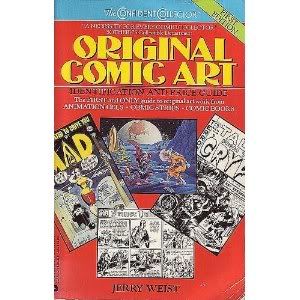
I first got to know him when he was working on his price guide for original comic art. I think the deal was that Kitchen Sink Press was going to publish it, but when KSP went under, he just self-published. But he came up to Northampton a couple of times to visit, and I persuaded him to include some more modern alternative comics artists like Dan Clowes and Adrian Tomine in the book. The book was itself a bit of a sham--the prices were based on real prices (Weist had lots of Sotheby's data to go by, plus he knew most of the dealers of original art in the country), but as I demonstrated in my analysis of Jaime Hernandez art prices, art from a single artist can vary wildly in price.
But on reflection, I don't think Jerry was trying to impose a price on the art he was listing. The thing was, the market for original comic art was very undeveloped then. (It's still hardly a mature market, in my mind.) The natural market for this artwork--comics fans--were still obsessed with collecting comic books. The market for collectible comic books had been carefully nurtured by Robert Overstreet for over 20 years by the time Jerry wrote his original art price guide, and Wizard Magazine pushed comics collecting even further. I think Jerry wanted to reach all those people who were buying collectible comics and say--here's something truly unique, the actual artwork. A price guide was a familiar way for those people to think about collecting, so I imagine Jerry thought it would be a good way to make them feel comfortable about a whole different level of collecting.
That said, I don't think it completely worked. Sotheby's discontinued its comics auctions (that business has largely moved online to Heritage Auction and eBay). But it worked well enough that Jerry published two editions. And things like this are needed--collecting original art can be very intimidating.
Jerry was an extremely likable guy who loved comics, comics artwork, and science fiction. He also introduced me to my favorite Italian dish, pasta puttanesca. So long, Jerry.




Hello Robert -- I didn't know Jerry personally (though I bought a Jacquet file copy from him awhile back), but like many I have been reflecting on his contributions to our segment of the culture since this news came.
ReplyDeleteYou're very right about comic art collecting -- I personally think any attempt at bringing more information to light is good, even if that info is imperfect at times.
I also think the Sotheby's auctions were an under-appreciated moment in our culture's evaluation of comic art. On the comic side, sales went from the occasional breathless newspaper "OMG comics are worth how much!?" piece to being commonplace and better understood, and as you imply the Sotheby's presentation and the additional focus on original art helped to shift the conversation to an appreciation of the form itself even when big money is involved.
In any case, thanks for your post. I have tremendous respect for those who have gone before in this business and Jerry Weist was definitely someone who played a role in building the business of comics.
--Mark Seifert